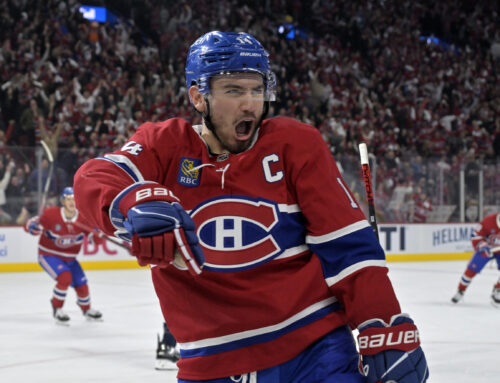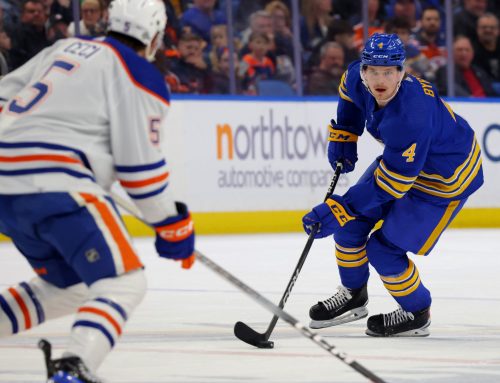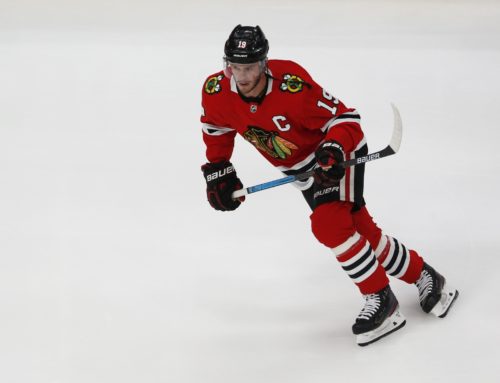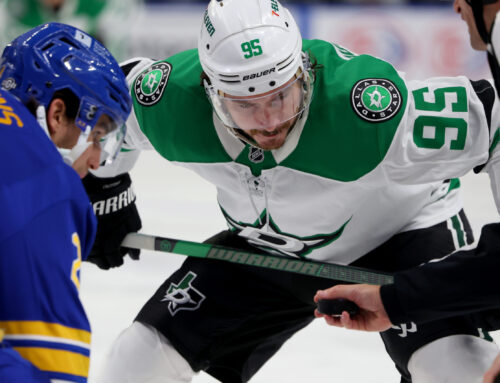
Starting next week, here at Dobber Hockey, we will be discussing bubble keeper players all week. Both the contributors whose articles are posted every day and the editors writing the Ramblings will cover skaters and goalie who may be on the bubble in keeper leagues. Leagues have different rules and different sizes, so it won’t be one-size-fits-all. But it will help those trying to decide between two players whose outlook may seem similar.
If the readers have any requests of myself (or others), feel free to tweet us (I’m @SlimCliffy) or leave questions in the comments. We’ll do our best to get to everyone.
Get ready for Bubble Week!
*
On the topic of Bubble Week, I wanted to get some input from the Dobber community.
I have a 10-team home league where I finished fourth last year despite having, what I thought, was a pretty good roster. Turns out goaltending is hard and aside from John Gibson (it’s a two-goalie league), relying on Cory Schneider and Scott Darling didn’t work out so well.
Anyway, I’ve started to think about keepers. It’s a 6×4 league with no positions, just forward, defence, and goaltender. We use goals, assists, plus-minus, power-play points, shots, and penalty minutes for skaters and wins, losses, goals against, and saves for goalies. It’s a points league.
Absolute locks for keepers so far are: Nathan MacKinnon, Vladimir Tarasenko, Mark Scheifele, William Nylander, Alexander Radulov, Brent Burns, and John Gibson. This is the rest of my roster to pick one more keeper:
.png)
Though I do like Jake Guentzel a lot, and expect a good year from Chris Kreider, this is going to come down to Viktor Arvidsson and Kevin Fiala. If you’re in a keeper league – and assume whichever player I don’t keep I will lose in the draft – which do you keep?
I know it seems like a slam-dunk for Arvidsson but I’ve long been a believer in Fiala and think he may be the better player right now, even if he’s still just 21 years old (if only for a couple more days).
*
The countdown to the release of the 2018-19 Dobber Hockey fantasy guide is winding down as we’re inside two weeks. Be sure to get a head start and dive into all the articles and projections contained within. Don’t worry about updates; the guide is constantly updated as new information becomes available. Head to the Dobber Shop and place a pre-order today!
*
Yesterday’s Ramblings covered a lot of the recent fantasy-relevant signings of late. There were a couple not covered so it’s worth going over them now. Cap information is from Cap Friendly.
The New York Rangers extended Jimmy Vesey’s stay in the Big Apple for another two years with an average annual value of $2.275-million.
As I mentioned yesterday, I’ve started compiling data for my 2018-19 projections. When going through some of these compilations, I noticed just how well Vesey compared to a lot of very notable fantasy hockey names by individual expected goals at five-on-five. Here are the list of players between 25-27 expected goals at five-on-five over the last two years (data from Corsica):

The list of wingers in that set are as follows: Josh Anderson, Brad Marchand, Dustin Brown, Blake Wheeler, Artturi Lehkonen, William Nylander, Justin Williams, Nikolaj Ehlers, Brock McGinn, Artemi Panarin, Jake Guentzel, Chris Kreider, and Filip Forsberg. The only one two who stand out are Lehkonen and McGinn and I think Lehkonen is just starting to scratch the surface of his fantasy potential. In all, it’s good company Vesey finds himself.
In terms of actual five-on-five goals scored last year, Vesey’s 0.86 compared favourably to guys like Jonathan Marchessault (0.88), Jaden Schwartz (0.87), and Evander Kane (0.86).
It’s a question of expectations and questioning those expectations. When he signed with the Rangers originally, it seemed there was a mix in the hockey community ranging from ‘star in the making’ to ‘he’s barely an NHLer.’ As is often the case, the answer seems to lie somewhere in the middle. In this instance, literally: Vesey has shown himself to be a very capable middle-six winger.
Whether Vesey takes the next step in fantasy relevance depends on usage. He’s averaged about 14 minutes a game over his first two years and that’s just not enough to put up the raw totals necessary to be relevant in most leagues. Will a new coaching regime give him more minutes or will it be status quo? It’s worth the risk in deeper leagues to draft him late but in shallower leagues he’s probably still waiver-wire material until something changes.
The New Jersey Devils signed centre Blake Coleman to a three-year deal with an average annual value of $1.8-million. Coleman had 25 points last year and is going into his age-27 season.
I understand that most people would not be excited about a 27-year old with 102 career NHL games and 27 career NHL points signing an extension. Please indulge me and come on down this rabbit hole.
When dealing with a player at his age with 102 games, we’re naturally going to be talking about small sample sizes and very little pedigree. That has to be understood.
Here’s the thing about fantasy hockey and fantasy sports in general: smart owners use small sample sizes to their advantage. Smart owners don’t avoid a player because he doesn’t have a long track record. People gunning for first place don’t avoid players who have small sample sizes; people destined for fifth place do. Often, players with small sample sizes, in particular ones without significant draft pedigree, come at a discount at the draft table. Jonathan Marchessault is the poster boy here considering even coming off a 30-goal season he was sometimes drafted outside the top-200 players in 2017-18.
Why it’s important to take these chances is because, sometimes, a player like Marchessault repeats, or comes close to repeating, his performance. Or sometimes, it’s a player like Yanni Gourde who does all the things we like to see in a small sample and provides immense value the following year.
If the player busts as a draft pick, there’s not much lost. If you’re in a 12-team league with 25 players per team, that’s a draft pool of 300 players. How much is lost in drafting a bust in the 18th or 19th round? Not much. The difference between that draft slotting and waiver replacements isn’t high. The value that can be gained, though, is huge.
Fantasy leagues aren’t won by drafting a safe player with a low ceiling 210th overall, they’re won by taking risks that the 210th player overall can be top-75 but has a good bust probability as well.
To get back to Coleman, think of it like this: Coleman is likely to be irrelevant in 12-team leagues, but he does have upside, and if he busts he’s easily replaceable.
Last year, Coleman was third on the Devils in shot attempts per 60 minutes at five-on-five. League-wide, his shot rate compared to guys like Tomas Hertl, Alex Galchenyuk, and Tyler Johnson. His individual expected goals per 60 minutes at five-on-five was 0.83. League-wide, that tied him with names like Derick Brassard, Travis Konecny, and Marchessault.
When looking at other metrics, namely playmaking ones, he doesn’t fare nearly as well. It’s one reason why he had more goals than assists last year. Here’s how he’s compared to Michael Cammalleri over the last two years (from CJ Turtoro’s viz). There’s a reason for that comparison:

Coleman has been good at getting the play started, and he can shoot with good volume. It’s everything in between that’s an issue.
That’s fine for our purposes. The guy knows how to get teammates the puck to get out of the zone and gets himself in shooting positions. All players going at his ADP will have holes in their game. If the worst we can say about him is he seems to care more about scoring goals than setting them up, well, there are worse problems to have.
Again, this isn’t some sort of prediction of a breakout. What I’m saying is the ingredients are there for Coleman to have a good season. Travis Zajac is in freefall and though I’m a believer in Pavel Zacha, it’s not certain he’ll be a full-time centre next year. Coleman could find himself with more minutes next year depending on the performance of others and he has the skills necessary to put up a sneaky 20-goal season. Do not ignore him in deeper leagues. Even if he busts, he can be had at such a discount that replacing him on the waiver wire is easy.
*
This is just your periodic reminder to draft Brandon Saad as often as possible this year. Thank you for your time.
*
Blake Coleman got me thinking about another Devils skater: Marcus Johansson.
Johansson missed nearly three months with a concussion thanks to a flying elbow from Brad Marchand. He eventually returned in the playoffs but for just a few games, not nearly enough to judge him, especially considering how much time he missed. He looks ready for 2018-19 and let’s hope the concussion issues are behind him.
It’s easy to forget that before getting to New Jersey, Johansson averaged 20 goals and 30 assists a season for three years. That was on a high-powered Washington team but Johansson was a fixture of the top PP unit with the Capitals.
Before the concussion issues started piling up, Johansson didn’t spend much time with the top PP unit in New Jersey. Does that change now? The three forwards seemingly locked into the top unit should be Hall, Nico Hischier, and Kyle Palmieri. Could Johansson be the fourth? It may be tough because assuming Will Butcher takes that spot again, it would give them four left-handed shots. That may open the door for someone else.
All the same, I will be paying attention in training camp. The Devils used a lot of different combinations last year but Johansson will get overlooked this year in fantasy. If he seems to have the inside track on the top PP unit, be sure to pencil him in at the end of your drafts. If he doesn’t, he can probably be left alone in most leagues.





 BUF
BUF NYR
NYR CHI
CHI WSH
WSH CBJ
CBJ S.J
S.J VAN
VAN PIT
PIT ANA
ANA TOR
TOR
